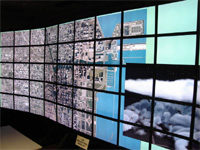EVL Lights Up the 105 Megapixel LambdaVision
July 19th, 2005 - September 30th, 2007
Categories: Devices

About
July 19, 2005 - CHICAGO, Illinois - Computer scientists at University of Illinois at Chicago’s (UIC) Electronic Visualization Laboratory (EVL) lit up LambdaVision this week, brilliantly illuminating high-resolution imagery on a 17-foot-wide by 6-foot-high wall of 55 LCD panels. LambdaVision has a total resolution of 105 million (mega) pixels.
“LambdaVision’s high resolution makes it possible to see the finest details,” said EVL director Jason Leigh. “The large context allows groups to simultaneously view and interact with the data.”
And, for some scientists, LambdaVision’s resolution is still not enough! For example, the U.S. Geological Survey (USGS) National Center for Earth Resources Observation and Science (EROS) is mapping 133 major U.S. cities at 0.3-meter resolution. Chicago data alone is 5,000 square miles of information; LambdaVision can display 3 square miles at full resolution.
Other EVL collaborators with very-high-resolution visualization needs include geoscientists studying seismicity and geomorphology data at University of California, San Diego’s (UCSD) Scripps Institution of Oceanography, and bioscientists at UCSD’s National Center for Microscopy and Imaging Research (NCMIR) investigating properties of the brain revealed in multiscale and multidimensional maps.
The goal of the LambdaVision project is to understand how to build visualization software and develop user interfaces for scalable displays. Scalable visualization software is a nascent set of programming challenges, and today’s desktop mouse-based user-interfaces work on small displays, but not larger displays that could potentially cover entire rooms.
Driving the system is EVL-developed software called SAGE: Scalable Adaptive Graphics Environment. SAGE takes input from a variety of sources - laptops, rendering clusters, and high-definition video - and displays them simultaneously and seamlessly on LambdaVision. It is similar to a desktop window manager, assigning different applications to different areas of the display.
“In the past, tiled displays have been mainly used to show one big picture,” said EVL Research Assistant Professor and chief SAGE designer Luc Renambot. “SAGE allows a variety of applications, at variable resolutions, to be juxtaposed on the large screen, which is the natural way scientists, engineers and analysts want to view information.”
The LambdaVision system consists of an 11x5 array of LCD panels, each with a resolution of 1600x1200 pixels, driven by a 30-node dual processor 64-bit cluster with 4GB RAM, several gigabit network interface cards and one high-end graphics card per node, and a total of 60 terabytes of storage. Each cluster node drives two LCD panels. The cluster both manages the display and serves as a rendering engine to produce visualization content.
SAGE and LambdaVision are always running, allowing the applications to constantly update the content, or alert users of significant changes. This makes the system ideal for Visual Analytics, a new field of study in which the analysis of data is coupled with data mining, high-resolution visualization and interaction.
LambdaVision is the culmination of three years of user studies, of both individuals and collaboration teams, working in display-rich environments. Not surprisingly, EVL researchers observed that when people work together, both locally and at a distance, having multiple displays showing what everyone is doing is beneficial.
A National Science Foundation (NSF) Major Research Infrastructure (MRI) award funded LambdaVision equipment. The NSF-funded OptIPuter project’s mission is to enable scientists to interactively explore massive amounts of previously uncorrelated data, and is supporting SAGE development. Development of interaction and collaboration techniques is supported by National Center for Supercomputing Applications (NCSA) Technology Research, Education, and Commercialization Center (TRECC).
Leigh and Renambot will present details of LambdaVision’s construction at the NSF CISE / RI PI meeting being held at NCSA on July 27, 2005